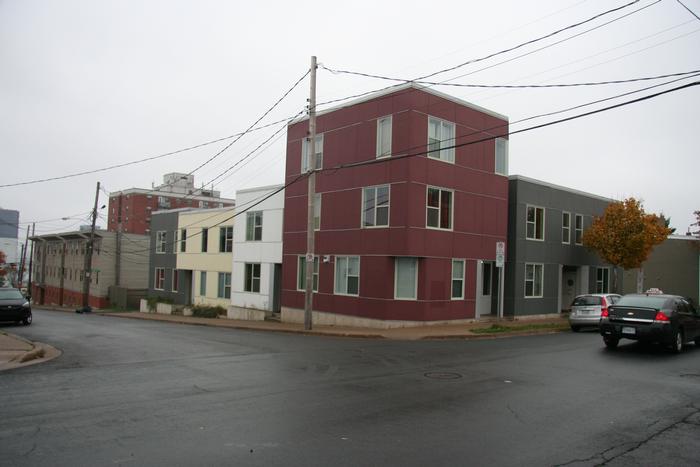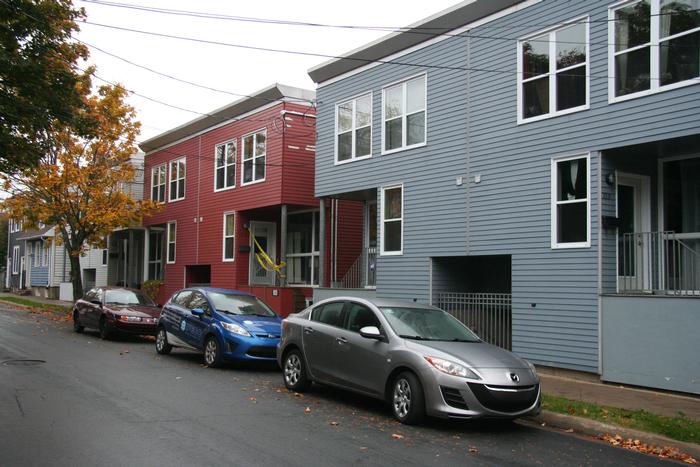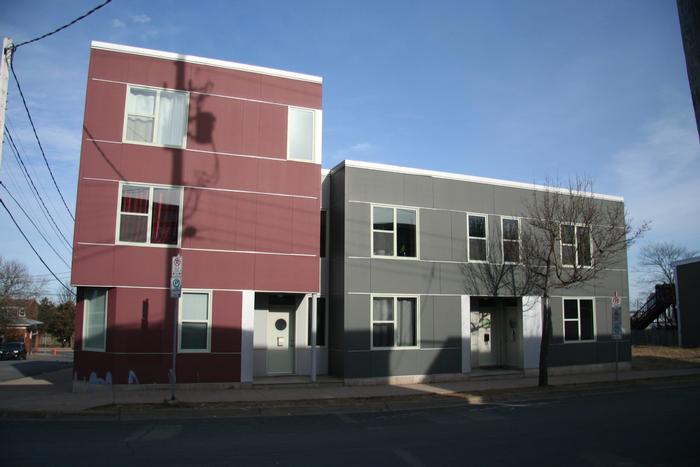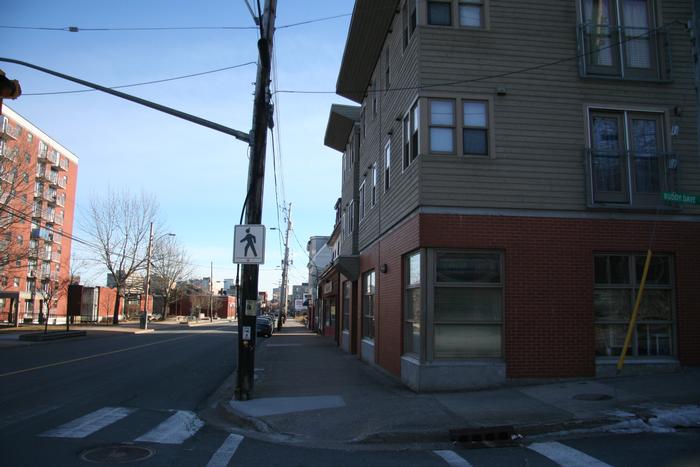[ID:1343] North End Halifax: Impact a Poverty-Stricken Community Through Small Scale ArchitectureCanada The month of April 2002 marked a new beginning for the North End neighborhood of Halifax, Nova Scotia. It was the month in which the Creighton/Gerrish Affordable Housing Initiative received the Lieutenant Governor’s Medal for Architecture, the highest award conferred to a building design in Nova Scotia by the provincial architectural association. The recipient was a local architect named Niall Savage who, following a three-year period of participatory design process, was honored by his confreres for his contribution to a poverty-stricken community. The Metro Non-Profit Housing was a breakthrough in many senses. It was to be the first property initiated by a group of nonprofit organizations, and developed through a participatory design process. It was also the first to lodge hard-to-house tenants in eighteen bachelor apartments, who would otherwise occupy the streets. Most importantly, it was set to be the initial project out of three phases that would redevelop an entire block in a struggling neighborhood. The remaining two complexes were six three-bedrooms townhouses sold to families with a governmental reduction grant on their mortgage and twelve rental apartments for moderate-income tenants along with students. Therefore, the month of April 2002 highlighted the accomplishment of an architectural intervention that was set to rejuvenate the broken urban fabrics of an underserved community, and it was merely the starting point of lengthy process in the following decade.
As an architecture student in Halifax, my understanding of the city was constrained to the culture of campus life. I had limited awareness of contrasting economic conditions present within the municipality. My peers vaguely mentioned the North End and the consensus of the neighborhood tended toward negativity. As a result, my impression of this part of the town was also tainted with the stigmatization advocated by most. In the media, drug abuse, violent crime, and unemployment are keywords that have consistently been featured to depict the undesirability of the area. Moreover, headlines about gentrification that speculated the inevitable future of the neighborhood in conforming to the standard of Halifax. Reports about condominium projects filling the gaps of the existing housing density have been a solution supported by many Haligonians. Although it revealed their indifference toward the current struggles of the neighborhood, these local residents preferred to entrust the North End to the capitalist endeavor of private developers.
On the other hand, architectural periodicals and newspapers branded the Creighton/Gerrish Affordable Housing Initiative as the answer to the conundrums of the area. Leading national architecture journal, Canadian Architect, published in July 2009 an article titled Eastern Promises describing the impact of the Initiative. It read: “Tenacity and perseverance have paid off through a series of affordable housing projects constructed over the past decade, dramatically improving the North End of Halifax.” The project was the solution that the stigmatized neighborhood longed for. It was an urban renewal embryo that would progressively effect the rejuvenation of the whole area. Similarly, The Globe and Mail, a daily paper distributed nationwide, has reported on the project. The journalist provided a thorough account of the development process, which was also topped by a sensational headline - Rebuilding Halifax’s Most Feared Neighborhood, One Project at a Time. The article even featured the spearhead of the Initiative - Grant Wanzel, a lifelong activist who have reinforced the concept of modest housing cost in an area resided mainly by a population in financial distress. Furthermore, the local media was equally receptive to the Initiative. The Coast, a local news website, has reported on its potential since 2006. Therefore, the press applauded the project for its intention to ameliorate an urban blight, and it prompted my desire to investigate further.
On a cold afternoon of January, I decided to venture into the infamous neighborhood. As I stepped into the first stretch of the North End, I recognized immediately the defeatist portrayals that I gathered from my colleagues. Gottingen Street, the commercial thread of the sector felt desolate. The building density was significantly lower than in Downtown Halifax located a few hundred meters south. The vividness of a bustling urban backdrop has also vanished. The Creighton/Gerrish development project was built five blocks into the neighborhood. While I drew nearer to the site, I encountered a multitude of nonprofits that occupied the storefronts on the street. YMCA Youth Services, Shelter Nova Scotia, and among others formed the social infrastructures of the area. For numerous North Enders, life in the city is contingent upon the assistance provided by these organizations. The municipal government on the other hand has failed to foster a sustainable tie with the residents.
The Initiative was as well a product of institutions. Headed by the Creighton/Gerrish Development Association in collaboration with Harbour City Homes and Metro Non-Profit Housing Society, the scheme was established in 1993. However, the partnerships were bound in 1995, and Grant Wanzel was named the president of the Association. In fact, when I was received subsequently by Prof. Wanzel in his office at Dalhousie University, he affirmed that four years of arduous negotiations with both the city and a national food retailer Sobeys Inc. took place in order to acquire through governmental loans the properties onto which the housing projects would be erected, and Niall Savage was only nominated as the architect following these arrangements. The plan was ambitious. By introducing social housing project in the heart of the North End, the Association aspired to relocate underprivileged residents into permanent homes. The intent was also to diversify the social economic conditions of the neighborhood by augmenting the density of a city block and bringing variety to the housing typology already in place. Furthermore, Savage’s design would take advantage of the terrain facing on one side Gottingen Street to introduce institutional use below apartments.
Five blocks into the neighborhood, I came to face the Metro Non-Profit Housing, the earliest phase of the Initiative that encompassed eighteen bachelor apartments for hard-to-house single tenants. Niall Savage’s design complemented tunefully the surrounding premises and filled the breaks in the disbanded architectural landscape, particularly in this intersection that used to be dubbed as the “Crack Corner”. While I peeked inside the street facing window on Gottingen, I realized that Savage’s institutional use vision was brought to fruition. Metro Non-Profit Housing’s office was stationed on the main floor, but on that day the doors were locked. Suddenly, a voice uttered behind my back. “The Coffee Shop is closed in the afternoon.” she claimed. It was Jennifer, a resident of the area who informed me that the Coffee Shop was the nickname adopted by the neighborhood. It was in fact a place of gathering for struggling locals with free hot beverages that opened four mornings a week. Jennifer was supportive of the project. She expressed that: “It gave the oomph that North End needed”.
A few days later, when I returned to the Coffee Shop in the morning, I acknowledged the “oomph” she described. The spirit of the place was overloaded with joy. Neighbors were sharing life stories around tables away from the bitter Canadian winter. Adam Craft, the Housing Support Coordinator of Metro Non-Profit, also met me during this second visit. He was the superintendent of the organization and assisted the eighteen tenants. “We love the building and it turned into the hub of the community. Since everyone in this home has experienced homelessness, the Coffee Shop has become the meeting place for folks facing housing instability and even mental health issues.” he revealed in his office. However, the only criticism he identified was the lack of a indoor hallway that connected the rooms. In order to access their living quarters, the tenants had to mount stairs in an outdoor courtyard behind the property, which posed challenges for disabled residents during unpleasant weather conditions. Subsequently, Adam introduced me to Fred, who has lived in the complex for the last six years. He disclosed that his three hundreds square feet apartment was comfortable. He also commented that it was conveniently located for the fees that he was paying since all residents’ monthly rent was geared to their earnings. In summary, Fred felt satisfied as he pointed out simply that: “This helps a lot of people.”
Following my chat with Jennifer, I moved onto the intersecting Buddy Daye Street. The Harbour City Home was the adjacent project that occupied the second portion of the block before intersecting Gerrish Street. Niall Savage partitioned the twelve units apartment, completed in 2008, into five standing volumes adjoined successively in a L-shape plan. The color of the facade of each volume reminded one of the polychromatic row houses commonly found in the Atlantic region. When I finally reached the first volume in yellow, I met a woman who lived two blocks east from the building. I invited her to review the project, and she kindly replied that: “It looks good in a place like this. It’s newer.” Then, another woman strolling with her children confessed that: “It renews the block and gives personality to it.” In reality, Niall Savage’s design has rekindled the confidence that the residents of the area have lost through marginalization. It became the trophy of an underserved community. A tenant of complex has also professed her appreciation of Savage’s work. “I love the layout of the building. It’s a good idea and it improves the image of North End. There is a waiting list to live in here and I feel fortunate.” she affirmed. Although she also voiced later on her discontent regarding the condensation of her windows, which have caused molding, Harbour City Home has been beneficial in diversifying the social economic conditions of the block by encouraging the working class and students to dwell in a disparaged sector that would otherwise remain buried under stigmatization.
As I turned onto Gerrish, I spotted three sets of semi-detached townhouses tightly positioned next to each other in the middle of the block. As the only properties purchased by residents from the area through a governmental reduction grant on their mortgage, the remaining phase was the most crucial piece of the Initiative. Savage’s design abides by the recurrent shingle style architecture found throughout the area with the exception of a floor to ceiling window overlooking the sidewalk. In fact, on that afternoon, all curtains were shut to fend off curious eyes. While I stared into my reflection, I questioned the lack of panoramic exploitation of the street view for the dwellers on the inside. To unearth the enigma, I rang the bell on one of the residences. A woman immediately emerged behind her drapes. She was bothered by my presence. “I don’t want crack! Go away!” she shrieked through the window. Dazed and confused, I spent a minute to convince her that I had no interest in narcotics, but I was a student. The woman was one of the six initial buyers. Although she was involved in a participatory design process with the architect, she remained disgruntled with her oversized window that was exposing the privacy of her living room. “I don’t have a river to look out to. Why do I need a giant window? There are people doing drugs on the street.” she remarked. However, following her eloquent disapproval of her window, she still applauded Grant Wanzel’s vision that enabled her to return to the neighborhood where she used to reside as a child across the street. Subsequently, I encountered a similar experience at the adjacent house when the proprietress was also hesitant in greeting me. She sneaked through her dark curtains with dubiousness, but once more I persuaded her to initiate a conversation. The second resident was affirmative of the project. “I bought it, so I am proud of it. And we need affordable housing in the North End.” she claimed with satisfaction. There was a common view shared by both homeowners. The Creighton/Gerrish Initiative has stabilized families within the volatile social economic environment of the North End. Two neighbors on the opposing side of Gerrish Street have also concurred with the proprietresses. Among them, a man professed the need for tasteful architecture to anchor inhabitants in the sector for it to rejuvenate. “Who doesn’t appreciate an inspiring building?” he reasoned as he left me to collect his mail.
In a capitalist culture, architecture has become the epitome of the economic and social prosperity of an urban milieu. While the architectural density and variety of Downtown Halifax has bespoken the interests of the community and businesses, the North End has displayed the lack of social and commercial viability with its disbanded architectural landscape. Nevertheless, the Creighton/Gerrish Initiative has exploited the potential of the struggling North End through architectural works to resuscitate its confidence in order to defy the current social economic quiescence of the area. For this reason, as an architect, I believe in the vision of the Grant Wanzel and Niall Savage. To retrofit an urban block at the heart of North End with three housing projects is to curtail the social and cultural monotony embedded in urban poverty. Moreover, to achieve it by means of participatory design in the case of the Metro Non-Profit building and the townhouses is to value the sustainability of the community set to dwell in the establishments of the project.
However, one can never cease to rethink a design and I argue in response that the Creighton/Gerrish Initiative can be strengthen to fulfill its endeavor to catalyze the whole area beyond the scope of an urban block as described in the media. Firstly, there needs to be a more extensive placement of institutional premises on Gottingen Street since non-profit organizations are at the core of the social infrastructure of the neighborhood that unites the community. In fact, when I was collecting the reactions from the local businesses, the convenience store, pizzeria, market, and medicinal marijuana clinic all nonchalantly demonstrated their careless stance regarding the three complexes. Thus, there was a dearth of a collectivity, but institutions such as the Coffee Shop can be instrumental to accentuate togetherness within the North End. Secondly, I dispute Niall Savage’s romantic attempt, ignited by the urban design literature of Jane Jacobs, to place eyes on the street. If the oversized windows of the townhouses have become fearful for the proprietors, I propose to scale down the vantage point to clearly distinguish the private from the public realm. As a result, the curtains will remain open and the stigmatization of the street will lessen.
All in all, the Creighton/Gerrish Affordable Housing Initiative marked a significant step in utilizing architectural works to ameliorate the life of the underprivileged Haligonians. Niall Savage’s design was successful in understanding the struggles experienced by an underserved community. In return, it also substantiated the potential in Halifax for the built environment to respond to social causes. Therefore, the Initiative has confirmed the relevance of architecture as a social art in the development of a city neighborhood, and it showcased the importance for architects to acknowledge the social benefits of their work.
If you would like to contact this author, please send a request to info@berkeleyprize.org. |




